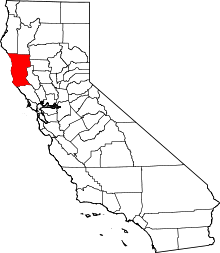Ukiah, California
| Ukiah, California | |
|---|---|
| City | |
| City of Ukiah | |
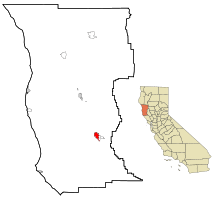 Location in Mendocino County and the State of California | |
 Ukiah Location in Mendocino County and the State of California  Ukiah Ukiah (the US) | |
| Coordinates: 39°09′01″N 123°12′28″W / 39.15028°N 123.20778°WCoordinates: 39°09′01″N 123°12′28″W / 39.15028°N 123.20778°W | |
| Country | United States |
| State | California |
| County | Mendocino |
| Incorporated | March 8, 1876[1] |
| Government | |
| • Type | Council/Manager[2] |
| • Mayor | Jim Brown[3] |
| • City manager | Sage Sangiacomo[2] |
| Area[4] | |
| • Total | 4.72 sq mi (12.23 km2) |
| • Land | 4.67 sq mi (12.10 km2) |
| • Water | 0.05 sq mi (0.14 km2) 1.11% |
| Elevation[5] | 633 ft (193 m) |
| Population (2010)[6] | |
| • Total | 16,075 |
| • Estimate (2017)[7] | 16,036 |
| • Density | 3,400.86/sq mi (1,312.96/km2) |
| Time zone | UTC−8 (Pacific) |
| • Summer (DST) | UTC−7 (PDT) |
| ZIP Codes | 95482 and 95418 |
| Area code | 707 |
| FIPS code | 06-81134 |
| GNIS feature IDs | 277623, 2412125 |
| Website |
www |
Ukiah (/juːˈkaɪə/ yoo-KY-ə; formerly Ukiah City)[8] is the county seat and largest city of Mendocino County, California. With its accessible location (along the U.S. Route 101 corridor several miles south of CA 20), Ukiah serves as the city center for Mendocino County and much of neighboring Lake County. The Ukiah Valley is a center of a major wine production industry. The population was 16,075 at the 2010 census.
History
Establishment
Ukiah is located within Rancho Yokaya, one of several Spanish colonial land grants in what was then called "Alta California". The Yokaya grant, which covered the majority of the Ukiah valley, was named for the Pomo word meaning "deep valley."[9] The Pomo are the indigenous people who occupied the area at the time of Spanish colonization. This word was also the basis for the city name, as Ukiah was an anglicized form of Yokaya.[10]
The first Anglo settler in the Ukiah area was John Parker, a vaquero who worked for pioneer cattleman James Black.[11] Black had driven his stock up the Russian River valley and took possession of a block of grazing land at that locale; a crude block house was constructed to house Parker in order to protect him and the herd from the hostile indigenous local population.[11] This block house was located just south of present-day Ukiah on the banks of what was known as Wilson Creek.[11]
The next Anglo settler was a man named Samuel Lowry, who in 1856 constructed a log cabin approximately on the corner of today's East Perkins Street and North Main Street.[11] Lowery sold his claim to A.T. Perkins in the spring of 1857, and the latter moved his family into the valley, thereby becoming the first pioneer family of the township.[11] Six others followed to make their home in the community that same year.[11] The first United States post office opened in 1858.[8] By 1859 the population of Ukiah had grown to about 100 people, making it a community sufficient in size to serve as the county seat when the California State Legislature divided Sonoma County to form Mendocino County in 1859.[12]
The town was initially reachable only by stagecoach, with a short rail line from San Francisco terminating in Petaluma, nearly 80 miles to the south, necessitating a horse-drawn trip taking two full days as late as 1870.[13] In subsequent years the rail line was extended further northward to Cloverdale, reducing the stagecoach trip to 30 miles — still enough to maintain the community's relative isolation and to fetter growth.[13]
Ukiah was finally incorporated in 1876.[8] It was not until 1889 that the San Francisco and North Pacific Railroad completed its line from Cloverdale to Ukiah, linking the Mendocino County seat to the national rail network at last.[14]
Economic history
Hops were once a predominant crop grown around Ukiah. The beer flavoring agent was first grown there in 1868 when L.F. Long of Largo grew an initial experimental crop.[13] The climate proved suitable for the crop and production expanded, peaking in 1885, before faltering somewhat in the last years of the 1880s due to declining prices.[13] Mendocino County remained the third-largest producer of hops in the state of California in 1890, with well over 900 acres under cultivation,[15] and production continued well into the 20th century. A refurbished hop kiln can be seen at the north end of Ukiah east of Highway 101, where many of the old fields were located.
Ukiah's 20th-century population developed in relation to the lumber boom of the late 1940s, with the logging of redwood being a major industry.
Geography
According to the United States Census Bureau, the city covers an area of 4.7 square miles (12 km2), 98.89% of it land, and 1.11% of it water.
Climate
Ukiah has a hot-summer Mediterranean climate (Köppen Csa). Average rainfall for the area is 36.96 in (939 mm) per year. Measurable precipitation occurs on an average of 82.1 days per year. The greatest monthly precipitation was 24.76 in (628.9 mm) in January 1995 and the greatest 24-hour precipitation was 6.18 in (157.0 mm) on December 22, 1964. The wettest “rain year” was from July 1997 to June 1998 with 72.74 inches (1,847.6 mm) and the driest from July 1976 to June 1977 with 14.20 inches (360.7 mm). Light snowfall occurs about every other year. The greatest recorded snowfall was 1.5 in (3.8 cm) on March 2, 1976, while the most in a month was 5 in (12.7 cm) in March 1896 and in January 1952.
| Climate data for Ukiah, California (1981–2010 normals, extremes 1893–2012) | |||||||||||||
|---|---|---|---|---|---|---|---|---|---|---|---|---|---|
| Month | Jan | Feb | Mar | Apr | May | Jun | Jul | Aug | Sep | Oct | Nov | Dec | Year |
| Record high °F (°C) | 82 (28) |
86 (30) |
93 (34) |
98 (37) |
105 (41) |
114 (46) |
114 (46) |
114 (46) |
115 (46) |
105 (41) |
92 (33) |
86 (30) |
115 (46) |
| Average high °F (°C) | 56.2 (13.4) |
59.8 (15.4) |
64.6 (18.1) |
68.9 (20.5) |
75.7 (24.3) |
82.7 (28.2) |
90.5 (32.5) |
89.9 (32.2) |
85.9 (29.9) |
76.0 (24.4) |
61.8 (16.6) |
54.9 (12.7) |
72.2 (22.3) |
| Daily mean °F (°C) | 46.8 (8.2) |
49.5 (9.7) |
52.6 (11.4) |
55.9 (13.3) |
61.6 (16.4) |
67.6 (19.8) |
73.4 (23) |
72.4 (22.4) |
68.7 (20.4) |
61.1 (16.2) |
51.3 (10.7) |
45.9 (7.7) |
58.9 (14.9) |
| Average low °F (°C) | 37.4 (3) |
39.2 (4) |
40.6 (4.8) |
42.8 (6) |
47.5 (8.6) |
52.6 (11.4) |
56.2 (13.4) |
54.9 (12.7) |
51.6 (10.9) |
46.3 (7.9) |
40.7 (4.8) |
37.0 (2.8) |
45.6 (7.6) |
| Record low °F (°C) | 12 (−11) |
18 (−8) |
22 (−6) |
23 (−5) |
28 (−2) |
35 (2) |
39 (4) |
38 (3) |
30 (−1) |
24 (−4) |
19 (−7) |
13 (−11) |
12 (−11) |
| Average precipitation inches (mm) | 7.41 (188.2) |
6.99 (177.5) |
5.42 (137.7) |
2.62 (66.5) |
1.49 (37.8) |
0.37 (9.4) |
0.02 (0.5) |
0.09 (2.3) |
0.43 (10.9) |
2.11 (53.6) |
5.07 (128.8) |
7.91 (200.9) |
39.93 (1,014.2) |
| Average snowfall inches (cm) | 0.2 (0.5) |
0.1 (0.3) |
0.1 (0.3) |
0 (0) |
0 (0) |
0 (0) |
0 (0) |
0 (0) |
0 (0) |
0 (0) |
0 (0) |
0 (0) |
0.4 (1) |
| Average precipitation days (≥ 0.01 in) | 12.7 | 11.9 | 11.1 | 7.5 | 4.7 | 1.5 | 0.1 | 0.3 | 1.6 | 4.4 | 10.3 | 13.3 | 79.4 |
| Source #1: NOAA[16][17] | |||||||||||||
| Source #2: WRCC (records only)[18] | |||||||||||||
The average high temperature is 73.5 °F (23.1 °C), and the average low temperature is 46.1 °F (7.8 °C). Temperatures reach 90 °F or 32.2 °C on an average of 65.6 afternoons annually and 100 °F or 37.8 °C on an average of 14.4 afternoons. Due to frequent low humidity, summer temperatures normally drop into the fifties at night. Freezing temperatures occur on an average 34.2 mornings per year. The record high temperature was 119 °F (48.3 °C) on July 22, 1995, and the record low temperature was 10 °F (−12.2 °C) on December 9, 1972. July is normally the hottest month with a normal high of 91.4 °F or 33.0 °C and a normal low of 55.3 °F or 12.9 °C. December has normally the coolest temperatures with a normal high of 55.6 °F or 13.1 °C and a normal low of 36.2 °F or 2.3 °C.[19]
Demographics
| Historical population | |||
|---|---|---|---|
| Census | Pop. | %± | |
| 1880 | 933 | — | |
| 1890 | 1,627 | 74.4% | |
| 1900 | 1,850 | 13.7% | |
| 1910 | 2,136 | 15.5% | |
| 1920 | 2,305 | 7.9% | |
| 1930 | 3,124 | 35.5% | |
| 1940 | 3,731 | 19.4% | |
| 1950 | 6,120 | 64.0% | |
| 1960 | 9,900 | 61.8% | |
| 1970 | 10,095 | 2.0% | |
| 1980 | 12,035 | 19.2% | |
| 1990 | 14,599 | 21.3% | |
| 2000 | 15,497 | 6.2% | |
| 2010 | 16,075 | 3.7% | |
| Est. 2017 | 16,036 | [7] | −0.2% |
| U.S. Decennial Census[20] | |||
2010
The 2010 United States Census[21] reported that Ukiah had a population of 16,075. The population density was 3,403.7 people per square mile (1,314.2/km²). The racial makeup of Ukiah was 11,592 (72.1%) White, 174 (1.1%) African American, 601 (3.7%) Native American, 412 (2.6%) Asian, 34 (0.2%) Pacific Islander, 2,385 (14.8%) from other races, and 877 (5.5%) from two or more races. Hispanic or Latino of any race were 4,458 persons (27.7%).
The Census reported that 15,301 people (95.2% of the population) lived in households, 281 (1.7%) lived in non-institutionalized group quarters, and 493 (3.1%) were institutionalized.
There were 6,158 households, out of which 2,049 (33.3%) had children under the age of 18 living in them, 2,317 (37.6%) were opposite-sex married couples living together, 938 (15.2%) had a female householder with no husband present, 356 (5.8%) had a male householder with no wife present. There were 484 (7.9%) unmarried opposite-sex partnerships, and 56 (0.9%) same-sex married couples or partnerships. 2,064 households (33.5%) were made up of individuals and 919 (14.9%) had someone living alone who was 65 years of age or older. The average household size was 2.48. There were 3,611 families (58.6% of all households); the average family size was 3.18.
The population was spread out with 3,981 people (24.8%) under the age of 18, 1,562 people (9.7%) aged 18 to 24, 4,184 people (26.0%) aged 25 to 44, 4,011 people (25.0%) aged 45 to 64, and 2,337 people (14.5%) who were 65 years of age or older. The median age was 35.9 years. For every 100 females, there were 92.8 males. For every 100 females age 18 and over, there were 89.3 males.
There were 6,488 housing units at an average density of 1,373.8 per square mile (530.4/km²), of which 2,673 (43.4%) were owner-occupied, and 3,485 (56.6%) were occupied by renters. The homeowner vacancy rate was 2.6%; the rental vacancy rate was 3.7%. 6,733 people (41.9% of the population) lived in owner-occupied housing units and 8,568 people (53.3%) lived in rental housing units.
2000
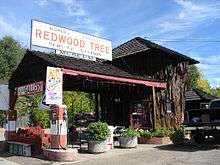
As of the census of 2000,[22] inside the city limits, there were 15,497 people in the city limits, 5,985 households, and 3,656 families residing in the city. The population density was 3,275/sq mi (1,265/km²). There were 6,137 housing units at an average density of 1,296/sq mi (501/km²). The racial makeup of the city was 79.5% White, 1.0% African American, 3.8% Native American, 1.7% Asian, 0.1% Pacific Islander, 9.7% from other races, and 4.3% from two or more races. Hispanic or Latino of any race were 19.3% of the population.
There were 5,985 households out of which 33.0% had children under the age of 18 living with them, 40.2% were married couples living together, 15.8% had a female householder with no husband present, and 38.9% were non-families. 32.2% of all households were made up of individuals and 14.5% had someone living alone who was 65 years of age or older. The average household size was 2.47 and the average family size was 3.12.
In the city, the population was spread out with 26.5% under the age of 18, 9.6% from 18 to 24, 28.1% from 25 to 44, 21.6% from 45 to 64, and 14.3% who were 65 years of age or older. The median age was 35 years. For every 100 females, there were 91.8 males. For every 100 females age 18 and over, there were 88.1 males.
The median income for a household in the city was $32,707, and the median income for a family was $39,524. Males had a median income of $31,608 versus $24,673 for females. The per capita income for the city was $17,601. About 13.2% of families and 18.1% of the population were below the poverty line, including 26.4% of those under age 18 and 7.8% of those age 65 or over.
As a community, Ukiah has roughly twice the number of people (including Redwood Valley, Potter Valley, Calpella, and Talmage) as the census reports. During the business day, an average of 40,000 people work inside the city limits, or in the business and residential neighborhoods to the north and south.
Economy
Major employers in Ukiah include:[23]
- Mendocino County
- Ukiah Valley Medical Center
- Walmart
- Savings Bank of Mendocino County
- Mendocino Community Health Clinics
- Granite Construction
- The Home Depot
- Lucky
Exports
Ukiah is known for wine production. The Ukiah vicinity is now home to some very large production wineries, including Brutocao, Fife, Parducci, Frey, and Bonterra. Ukiah vintners are known for innovating with organic and sustainable practices.
Ukiah was previously a major producer of pears. Alex R. Thomas & Company owned hundreds of acres of Bartlett pear orchards on the east side of the Ukiah Valley. For nearly 90 years, many local residents and migrant workers have been employed packing the pears for domestic and foreign consumption. On December 1, 2008, the company announced it would be shutting down major operations at the end of the year due to bankruptcy.[24] Several acres of orchard have been torn down and replaced with vineyards since the packing shed closed its doors. As of 2011, the main facility was slated to reopen as a composting and trash-sorting facility.[24]
The Ukiah Valley is home to two breweries, the Mendocino Brewing Company and the Ukiah Brewing Company. Mendocino Brewing Company was the first brewpub in California and second in the US. The Ukiah Brewing Company is America's first certified organic brewpub, and the nation's second organic restaurant.
Other important Ukiah products include grapes (for wine and non-wine use) and lumber. The Ukiah area is at the headwaters of the Russian River. Its rich bottomland supports many small, mostly organic farms that grow fruits and vegetables, and supports sheep and cattle.
Arts and culture
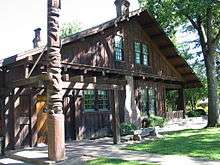
Institutions of the arts include:
- SPACE - School of Performing Arts and Cultural Education
- Ukiah Players Theatre
- The Mendocino Ballet
- Ukiah Civic Light Opera
- Grace Hudson Museum
- Ukiah Symphony Orchestra
- The Spring House
Government
Ukiah uses a council–manager form of government in which policy is set by a five-member city council, elected at-large to four-year terms. The council appoints both the mayor and the city manager.[25]
- Mayor until 2018 - Jim Brown[3] (appointed by council based on seniority for a one-year term)
- City council:
- City Manager - Sage Sangiacomo [26]
- City Treasurer - Allen Carter[3]
- City Clerk - Kristine Lawler[27] (appointed)
- City Attorney - David Rapport[28]
In the California State Legislature, Ukiah is in the 2nd Senate District, represented by Democrat Mike McGuire,[29] and the 2nd Assembly District, represented by Democrat Jim Wood.[30]
In the United States House of Representatives, Ukiah is in California's 2nd congressional district, represented by Democrat Jared Huffman.[31]
The tribal headquarters of both the Pinoleville Pomo Nation and the Potter Valley Tribe are in Ukiah.[32]
Education
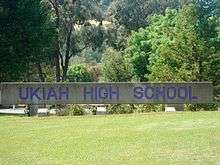
Ukiah Unified School District
- Ukiah High School
- Calpella Elementary School
- Eagle Peak Middle School (Redwood Valley)
- Nokomis Elementary School
- Oak Manor Elementary School
- Pomolita Middle School
- South Valley High School
- Yokayo Elementary School
- Frank Zeek Elementary School
- Tree of Life Montessori Charter School
- Grace Hudson Elementary School
- River Oak Charter School
- Ukiah Independent Study Academy
Other K–12 schools
- Accelerated Achievement Academy
- Redwood Academy of Ukiah
- Deep Valley Christian School
- Ukiah Junior Academy
- Instilling Goodness / Developing Virtue School
- St. Mary of the Angels Catholic School
Former K–12 schools
Colleges
Notable people
- AFI lead vocalist Davey Havok, guitarist Jade Puget, drummer Adam Carson, merchandise manager Jake MacLachlan and tour manager Smith Puget were all raised in Ukiah,[35] as were original-lineup guitarist Mark Stopholese and bassist Vic Chalker.
- Nick 13, lead singer of Tiger Army, was raised in Ukiah.[36]
- Edmond W. Burke, Ukiahi 1953, became Chief Justice of the Alaska State Supreme Court.
- Edward Burke, U.S. Olympic hammer thrower.[37]
- Wayne P. Burke, born and raised on Boonville Road, became a California State Superior Court Justice.
- Aurelius O. Carpenter, photographer
- Melissa Chaty, beauty queen, was Miss California in 2008.[38]
- McKenna Faith, singer-songwriter, is from Ukiah.[39][40]
- Shiloh Fernandez, actor, was born and raised in Ukiah.[41]
- Robben Ford, blues guitarist, was raised in Ukiah.[42][43]
- Grace Hudson, museum founder and collector of Pomo artifacts, was a commercial portrait photographer in Ukiah.[44] The Grace Hudson Museum in Ukiah is named for her and houses her collections.[45]
- Leonard Lake, serial killer, lived near Ukiah in the early 1980s.[46]
- Darrell McClure, a cartoonist of Little Annie Rooney and illustrator, was born in Ukiah to the painter Ethel Jameson Docker.[47]
- Holly Near, singer-songwriter, was born in Ukiah.[48]
- Hal Perry, raised in Ukiah, became a professional American basketball player and civil-rights lawyer.[49]
- Aaron Rodgers, National Football League Quarterback, spent four years of his childhood in Ukiah.[50][51]
- Carl Sassenrath, architect of operating systems and computer languages, created the Amiga computer operating system in 1985, later worked at Apple, subsequently moved to and runs his own company at his Ukiah ranch.[52]
- William Harrison Standley, Chief of Naval Operations and later U.S. Ambassador to the Soviet Union, was born in Ukiah.[53]
- Gary Scott Thompson, television and film screenwriter and producer, graduated from Ukiah High School in 1977.
- Rick Warren, pastor, author and Ukiah High School graduate,[54] was raised in Ukiah before his family moved to Southern California.[55]
- Bay Raitt, animator and video game designer known for developing Gollum's facial modeling in the Lord of the Rings films and other various works.[56]
In popular culture
- "Ukiah" is the name and subject of a song on the 1973 Doobie Brothers album The Captain and Me.
- Ukiah is featured prominently in C.D. Payne's novel Youth in Revolt.
- Ukiah is briefly mentioned in the 1987 film Dragnet.
- Ukiah is one of six original locations of an International Latitude Observatory.
- Some Ukiah-area soils are likely to contain naturally occurring asbestos (NOA), as do many other parts of California.[57]
- Competing in the men's Division III club level bracket, the Mendocino Steam Donkeys Rugby Football Club rugby union team, based in the Ukiah area, are the first official NCRFU team in the county.
- Ukiah is also well known as the home of the City of Ten Thousand Buddhas. Located east of Ukiah, the 488-acre (1.97 km2) temple is one of the largest Mahayana Buddhist communities in the Western Hemisphere. North of town is Abhayagiri Buddhist Monastery, a community in the Thai Forest Tradition of Theravada Buddhism.
- Ukiah's newspaper is the Ukiah Daily Journal.
- Ukiah is featured in the 2016 Czech video game, American Truck Simulator.
- Ukiah was named one of the "Top 18 Spots for Fall Color" according to Sunset.com.[58]
- Mentioned in television series Sons Of Anarchy
See also
References
- ↑ "California Cities by Incorporation Date". California Association of Local Agency Formation Commissions. Archived from the original (Word) on November 3, 2014. Retrieved August 25, 2014.
- 1 2 "City Manager's Office". City of Ukiah, CA. Retrieved January 21, 2015.
- 1 2 3 4 5 6 7 "Ukiah City Council". City of Ukiah, CA. Retrieved January 21, 2015.
- ↑ "2016 U.S. Gazetteer Files". United States Census Bureau. Retrieved Jun 28, 2017.
- ↑ "Ukiah". Geographic Names Information System. United States Geological Survey. Retrieved February 25, 2015.
- ↑ "Ukiah (city) QuickFacts". United States Census Bureau. Archived from the original on February 26, 2015. Retrieved February 25, 2015.
- 1 2 "Annual Estimates of the Resident Population: April 1, 2010 to July 1, 2017". Retrieved September 1, 2017.
- 1 2 3 Durham, David L. (1998). California's Geographic Names: A Gazetteer of Historic and Modern Names of the State. Clovis, Calif.: Word Dancer Press. p. 162. ISBN 1-884995-14-4.
- ↑ History of Ukiah, California (Part 1) in History of Mendocino County, California. San Francisco, California: Alley, Bowen & Co., (rays-place.com). 1880. Retrieved 5 September 2015.
- ↑ Alfred L. Kroeber, "California Place Names of Indian Origin," Archived July 20, 2011, at the Wayback Machine. University of California Publications in American Archaeology and Ethnology, vol. 12, no. 2 (1916), pp. 31-69.
- 1 2 3 4 5 6 Lyman Palmer, History of Mendocino County, California, Comprising Its Geography, Geology, Topography, Climatography, Springs and Timber. San Francisco, CA: Alley, Bowen and Co., 1880; pg. 475.
- ↑ Palmer, 'History of Mendocino County, California, pg. 476.
- 1 2 3 4 Carl Purdy, "Ukiah, 1870-1890: Interesting Reminiscences; Progress Made; Products of Our Valley," Dispatch-Democrat [Ukiah City], vol. 21, no. 15 (Jan. 10, 1890), pg. 2.
- ↑ Stindt, Fred A. (1978). The Northwestern Pacific Railroad Redwood Empire Route (3rd ed.). Fred A. Stindt.
- ↑ "Hops," Dispatch-Democrat [Ukiah City], vol. 21, no. 20 (Feb. 14, 1890), pg. 1.
- ↑ "NowData - NOAA Online Weather Data". National Oceanic and Atmospheric Administration. Retrieved July 30, 2016.
- ↑ "CA Ukiah". National Oceanic and Atmospheric Administration. Retrieved July 30, 2016.
- ↑ "UKIAH, CALIFORNIA - Climate Summary". dri.edu.
- ↑ National Climatic Center (ggweather.com)
- ↑ "Census of Population and Housing". Census.gov. Retrieved June 4, 2015.
- ↑ "2010 Census Interactive Population Search: CA - Ukiah city". U.S. Census Bureau. Retrieved July 12, 2014.
- ↑ "American FactFinder". United States Census Bureau. Retrieved 2008-01-31.
- ↑ "North Bay Business Journal: Book of Lists # North San Francisco Bay Area, Sonoma, Marin, Napa counties". lists.northbaybusinessjournal.com. Retrieved March 14, 2018.
- 1 2 Anderson, Glenda (July 26, 2011). "New life for old Ukiah pear-packing plant". Santa Rosa Press Democrat. Retrieved 2018-08-25.
- ↑ "City Hall". City of Ukiah. Retrieved February 5, 2015.
- ↑ "Ukiah reorganizes with new city manager". ukiahdailyjournal.com. Retrieved March 14, 2018.
- ↑ "Office of the City Clerk". City of Ukiah, CA. Retrieved March 8, 2015.
- ↑ "REACTION to the Kelly decision: David Rapport, Ukiah City Attorney". Ukiah Daily Journal. January 21, 2010. Retrieved 2017-04-22.
- ↑ "Senators". State of California. Retrieved March 10, 2013.
- ↑ "Members Assembly". State of California. Retrieved March 2, 2013.
- ↑ "California's 2nd Congressional District - Representatives & District Map". Civic Impulse, LLC. Retrieved March 1, 2013.
- ↑ California Tribes and Organizations, 500 Nations, retrieved 3 August 2009
- ↑ Cinek, Zack; Krauth, Monica (May 28, 2009). "Trinity School in Ukiah to close - update". Ukiah Daily Journal. Archived from the original on November 3, 2014. Retrieved November 2, 2014.
- ↑ Anderson, Glenda (July 31, 2009). "Ukiah youth home shuts its doors". The Press Democrat. Archived from the original on November 3, 2014. Retrieved November 2, 2014.
- ↑ "AFI Biography". Archived from the original on December 1, 2007. Retrieved 2007-12-01.
- ↑ "Ghost Tigers: Frequently Asked Questions". Retrieved 2007-12-01.
- ↑ Edward Burke, SR/Olympic Athletes, 2013
- ↑ Mason, Clark (January 27, 2008). "Ukiah's own just misses Miss America crown". The Press Democrat. Archived from the original on August 14, 2011. Retrieved November 3, 2014.
- ↑ Taylor, Dan (2011-01-15). "Ukiah Teen's Faith in music". Press Democrat. Retrieved 2011-09-23.
- ↑ Maginnis-Honey, Amy (2011-09-21). "16-year-old aspires to country music career". Daily Republic. Retrieved 2011-09-23.
The Ukiah resident
- ↑ Hester, Carole (December 27, 2013). "Looking About". Ukiah Daily Journal. Retrieved 2017-04-22.
- ↑ Tony Russell (August 1997). The blues: from Robert Johnson to Robert Cray. Schirmer Books. ISBN 978-0-02-864862-0.
- ↑ Vintage Guitar magazine interview, April 29, 2001
- ↑ Searles R. Boynton (1978). The painter lady: Grace Carpenter Hudson. Interface California Corporation. ISBN 978-0-915580-04-0.
- ↑ Our Story, Grace Hudson Museum, 2013
- ↑ Newton, Michael (1999). The Encyclopedia of Serial Killers. p. 134. ISBN 0-8160-3979-8.
- ↑ Darrel McClure Biography, Ask Art, 2013
- ↑ "Holly Near Biography". Retrieved 2007-12-01.
- ↑ Harold Leonard Perry Sr., Inside Bay Area from May 3–4, 2009, accessed October 10, 2013
- ↑ "'Free throws' are his forte". Ukiah Daily Journal. January 3, 1993. p. 1. Retrieved March 14, 2012.
- ↑ Jackel, Pete (October 6, 2005). "Focus on Football: Rodgers preparing for his moment". RacineSportsZone.com. JournalTimes.com. Retrieved March 14, 2012.
- ↑ Jeudy, Sébastien, Interview with Carl Sassenrath, Obligement, May 2007, accessed October 10, 2013
- ↑ "Jeremiah M "Doc" Standley". Find a Grave. Retrieved 2011-04-04.
- ↑ Brodsky, Carole (January 18, 2009). "Local boy makes great: the Rick Warren story". Ukiah Daily Journal. Retrieved May 18, 2016.
- ↑ George Mair (February 18, 2005). A life with purpose: Reverend Rick Warren, the most inspiring pastor of our time. Berkley Books. p. 34. ISBN 978-0-425-20174-9.
- ↑ "'Lord of the Rings' Animation Supervisor Randall William Cook Speaks Out On Andy Serkis". 2014-05-13.
- ↑ http://www.co.mendocino.ca.us/aqmd/NOA.htm
- ↑ http://www.sunset.com/travel/outdoor-adventure/fall-color?&PromKey=XET&iid=newsletter-su-travel-09062017
Further reading
- Aurelius O. Carpenter and Percy H. Millberry, History of Mendocino and Lake Counties, California: With Biographical Sketches of the Leading Men and Women of the Counties Who Have Been Identified with their Growth and Development from the Early Days to the Present. Los Angeles, CA: Historic Record Co., 1914.
- Lyman Palmer, History of Mendocino County, California, Comprising Its Geography, Geology, Topography, Climatography, Springs and Timber. San Francisco, CA: Alley, Bowen and Co., 1880.
External links
| Wikimedia Commons has media related to Ukiah, California. |
| Wikivoyage has a travel guide for Ukiah. |
